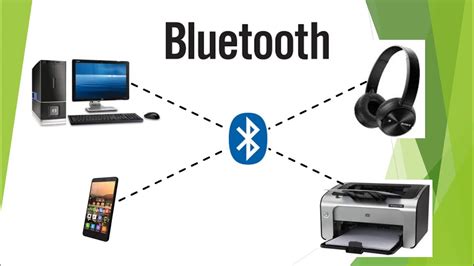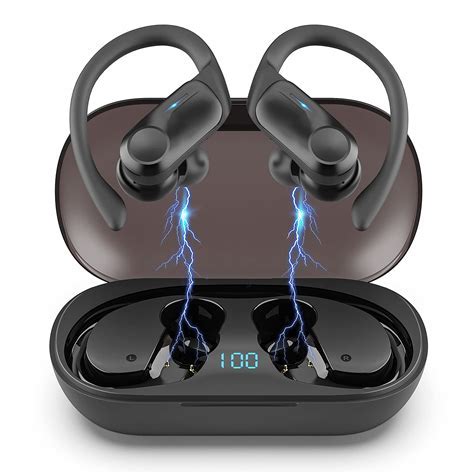Have you ever wondered about the mysterious mechanisms at play behind the seamless communication enabled by wireless headphones? When engaging in a phone call or recording audio, it can feel like magic as your voice is transmitted effortlessly through the airwaves. In this article, we will unravel the intricacies of wireless headphone microphones and shed light on the astonishing processes that make this technology possible.
Firstly, let's delve into the marvels of wireless connectivity. Unlike traditional wired headphones, Bluetooth headphones tap into the power of radio waves to establish a connection between your device and the headphones themselves. This means that you can bid farewell to entangled cables and revel in the freedom that Bluetooth technology provides.
Now, let's focus on the tiny yet mighty component that captures and amplifies your voice - the microphone. Embedded discreetly within the sleek design of Bluetooth headphones, the microphone's primary function is to convert acoustic waves, created by your vocal cords, into electrical signals. These electrical signals are then transmitted through the air to the receiving device, where they are converted back into soundwaves and can be heard by the intended listener.
Not all microphones are created equal, however. Bluetooth headphones employ various types of microphones, each with its own set of strengths and weaknesses. One common type is the electret condenser microphone. This type of microphone utilizes a thin diaphragm and a backplate to generate electrical signals. Another type is the MEMS (Micro-Electro-Mechanical Systems) microphone, which employs a tiny suspended diaphragm and a backplate etched on a silicon wafer. These variations in design result in differences in sensitivity, frequency response, and noise levels.
As you can see, the functionality of a Bluetooth headphone microphone is a fascinating blend of science and engineering. From converting soundwaves into electrical signals to ensuring wireless connectivity, these microphones play a pivotal role in delivering crystal clear audio during phone calls, voice recordings, or even virtual meetings. So, the next time you don your Bluetooth headphones and engage in a conversation, take a moment to appreciate the intricate technology working behind the scenes to make your communication effortless and convenient.
The Basics of Bluetooth Technology

In this section, we will explore the fundamental principles and mechanisms behind Bluetooth technology. Rather than delving into specific technical details, we aim to provide a general understanding of how Bluetooth works and its relevance in the context of wireless headphones with a built-in microphone.
Bluetooth is a wireless communication protocol that facilitates data transmission between devices over short distances. It operates on the 2.4 GHz frequency band and utilizes low-power radio waves to establish connections. Bluetooth technology offers the convenience of wirelessly connecting various devices, such as smartphones, tablets, laptops, and headphones, enabling seamless communication and data transfer.
One of the key components of Bluetooth technology is the ability to create personal area networks (PANs) or "Bluetooth networks." These networks allow devices within close proximity to identify and connect to each other. Bluetooth devices employ a process called pairing, where they exchange specific codes or passkeys to establish a secure and encrypted connection. Once paired, devices can communicate with each other without the need for wires or physical connections.
Bluetooth headphones with an integrated microphone leverage the benefits of Bluetooth technology to provide hands-free communication. The microphone within these headphones captures the user's voice and converts it into an electrical signal. This signal is then transmitted via Bluetooth to the paired device, such as a smartphone or computer, for processing and transmission to the recipient. Additionally, Bluetooth headphones often incorporate additional features, such as noise cancellation and echo reduction, to enhance the overall audio quality during phone calls or voice recordings.
In conclusion, understanding the basics of Bluetooth technology is crucial to comprehend the functionality of a microphone in Bluetooth headphones. By utilizing Bluetooth, these headphones can establish wireless connections with compatible devices and allow for convenient and seamless communication experiences.
Understanding the Different Microphone Types
In the realm of audio technology, microphones play a crucial role in capturing and transmitting sound. However, not all microphones are created equal. They come in various types, each with its own unique characteristics and applications. By understanding these different microphone types, you can gain insight into their functionality and choose the one that best suits your needs.
1. Condenser Microphones: These microphones utilize a thin diaphragm that vibrates in response to sound waves, converting them into an electrical signal. Due to their sensitivity and accurate sound reproduction, condenser microphones are commonly used in studio recordings, podcasting, and broadcasting.
2. Dynamic Microphones: Unlike condenser microphones, dynamic microphones use a moving coil attached to a diaphragm to convert sound waves into electrical signals. These microphones are known for their durability, versatility, and ability to handle high sound pressure levels, making them ideal for live performances, vocals, and instruments.
3. Lavalier Microphones: Lavalier microphones, also known as lapel microphones, are small and discreet. They are designed to be attached to clothing and are commonly used in presentations, interviews, and video recordings. Lavalier microphones allow for hands-free operation and offer a close microphone-to-mouth distance for clear audio capture.
4. Shotgun Microphones: Shotgun microphones are highly directional and designed to capture sound from a specific direction, while minimizing background noise. These microphones are commonly used in film production, outdoor recording, and interviews, where the focus is on capturing audio from a specific source while rejecting ambient noise.
5. Wireless Microphones: As the name suggests, wireless microphones do not require a physical connection to the recording device. They use radio frequency transmission to send audio signals, providing freedom of movement. Wireless microphones are widely used in live performances, public speaking events, and broadcasting.
By familiarizing yourself with the different microphone types, you can make informed decisions when it comes to choosing the right microphone for your specific audio recording or communication needs. Each microphones type has its strengths and weaknesses, so understanding their characteristics will allow you to achieve the best possible sound quality for your intended applications.
Exploring the Role of the Microphone in Wireless Earphones

The microphone is a vital component in wireless earphones, serving a crucial role in enhancing the user experience and functionality. By capturing audio input, it enables users to engage in hands-free communication, voice commands, and audio recording, while also allowing for effective noise cancellation and audio quality during phone calls or media playback.
- Enabling Hands-Free Communication: The microphone in wireless earphones allows users to make and receive phone calls without the need for a traditional handset. By capturing the user's voice, it enables seamless conversation while keeping the hands free for other activities.
- Enabling Voice Commands: Integrated microphones in Bluetooth earphones empower users to interact with smart assistants, such as Siri or Google Assistant, by simply giving voice commands. This feature facilitates tasks like setting reminders, playing music, or accessing information, without the need to take out the phone.
- Facilitating Audio Recording: The microphone also serves as a tool for audio recording, making it convenient for users to capture voice memos, interviews, or podcasts while on the go. It eliminates the need for additional recording devices, providing a compact and efficient solution.
- Effective Noise Cancellation: Many wireless earphones use a combination of the microphone and advanced algorithms to cancel out background noise during phone calls or media playback. By capturing ambient sounds and analyzing them, the microphone helps in reducing unwanted disturbances and enhancing the clarity of the audio signal.
- Enhancing Audio Quality: In addition to noise cancellation, the microphone plays a role in optimizing the overall audio quality experienced by the user. It helps in capturing clear and natural voice transmission, contributing to a more immersive and enjoyable listening experience.
In conclusion, the microphone in wireless earphones plays a multi-faceted role that goes beyond simple voice transmission. Its integration enables hands-free communication, voice commands, audio recording, noise cancellation, and improved audio quality, collectively enhancing the overall functionality and user experience of Bluetooth earphones.
Understanding Noise-Canceling Technology in Wireless Headsets
Wireless headsets with noise-canceling technology provide an enhanced audio experience by minimizing external sounds. This innovative feature enables users to enjoy their favorite music, podcasts, or phone conversations without distractions from surrounding noise.
- Noise-canceling technology in Bluetooth headphones actively reduces unwanted sounds.
- By using built-in microphones, these headphones detect ambient noise and generate an opposing sound wave, canceling out undesirable sounds.
- Through advanced algorithms and signal processing, noise-canceling headphones analyze the incoming audio and create anti-noise to counteract external sounds effectively.
- These headphones employ different methods to counteract noise, including passive and active noise cancellation techniques.
- In passive noise cancellation, the physical design of the headphones itself helps block out ambient sounds.
- In active noise cancellation, the headphones actively emit anti-noise to counterbalance external sounds.
- Noise-canceling technology is particularly useful in environments with consistent background noise, such as planes, offices, or public transportation.
By providing a quieter and more immersive audio experience, noise-canceling technology in Bluetooth headphones significantly enhances overall sound quality, making them a popular choice for individuals seeking both convenience and audio excellence.
The Importance of Microphone Placement for Clear Audio

When using wireless headphones with built-in microphones, the proper placement of the microphone plays a crucial role in ensuring clear and high-quality sound during calls or recordings. Positioning the microphone in an optimal location helps capture and transmit audio accurately, resulting in a better communication experience for the users.
A key aspect of microphone placement is finding the balance between positioning the microphone close enough to capture sound effectively and avoiding any unwanted background noise. Placing the microphone too far away from the source may result in a weak and distant sound, making it difficult for the listener to clearly understand the speaker. On the other hand, placing it too close can lead to distortion and muffled audio.
Another factor to consider is the directionality of the microphone. Some microphones have a unidirectional pattern, meaning they are most sensitive to sound coming from one specific direction. Others have an omnidirectional pattern, allowing them to pick up sound equally from all directions. Understanding the characteristics of the microphone and adjusting its placement accordingly can help enhance the clarity and quality of the audio.
In addition to placement, physical obstructions such as clothing or hair can also impact the performance of the microphone. It is important to ensure that the microphone is not obstructed by any objects that can interfere with the sound capture. Adjusting the position or using accessories such as windshields or clip-on mounts can help overcome these challenges and improve the audio output.
Lastly, the specific task or environment in which the microphone is being used may require different placement techniques. For example, when using the headphones for phone calls, positioning the microphone closer to the mouth can enhance voice clarity. For recording purposes, finding the optimal placement for capturing specific sounds or minimizing background noise becomes essential.
- Proper microphone placement enhances audio quality and improves the communication experience.
- Balance between proximity to the sound source and avoiding background noise is crucial.
- Understanding the microphone's directionality helps optimize placement.
- Obstructions such as clothing can negatively affect microphone performance.
- Varied placement techniques may be required based on the purpose of microphone usage.
Enhancing Microphone Performance through Sound Processing Algorithms
In this section, we will explore the various ways in which the performance of microphones in Bluetooth headphones can be enhanced through the application of sound processing algorithms.
Microphones play a crucial role in the functionality of Bluetooth headphones as they capture sound and convert it into electrical signals. However, the quality of the captured sound can be influenced by various factors such as background noise, distortions, and limitations in frequency response.
To overcome these limitations and optimize microphone performance, sound processing algorithms can be applied. These algorithms analyze and manipulate the electrical signals from the microphone to minimize noise, enhance voice clarity, and improve overall audio quality.
One commonly used sound processing algorithm is noise cancellation, which aims to reduce unwanted background noise. This can be achieved through various techniques, including passive noise cancellation that utilizes physical materials to block out external sounds, as well as active noise cancellation that uses microphones to actively detect and cancel out background noise.
Another important sound processing algorithm is echo cancellation, which addresses the issue of audio feedback. When a microphone picks up sound from speakers, it can create an echo effect, leading to distorted audio. Echo cancellation algorithms analyze and remove the echo, resulting in clear and natural-sounding audio.
Furthermore, equalization algorithms can help optimize the frequency response of the microphone, ensuring that it captures a balanced and accurate representation of different sound frequencies. This can enhance the overall clarity and richness of the recorded audio.
In addition to these algorithms, advanced signal processing techniques such as beamforming can also be employed to improve the microphone's performance. Beamforming algorithms focus on capturing sound from a specific direction while minimizing noise from other directions. This can be particularly useful in noisy environments where the microphone needs to isolate the desired audio source.
Overall, the application of sound processing algorithms is essential for enhancing the performance of microphones in Bluetooth headphones. These algorithms work together to reduce noise, cancel echoes, optimize frequency response, and improve the overall audio quality, resulting in a better user experience for Bluetooth headphone users.
Improving Voice Quality in Wireless Phone Conversations

Enhancing the clarity and fidelity of audio during wireless phone calls is a continuous endeavor in the realm of technology. Engineers and researchers are constantly seeking innovative approaches to refine the voice quality experienced by users when engaging in Bluetooth phone conversations. This section explores several techniques and advancements aimed at improving the overall voice quality in wireless communication.
- Background Noise Reduction: One key aspect to enhance voice quality lies in mitigating background noise interference. Advanced algorithms and signal processing techniques are employed to distinguish between the user's voice and unwanted ambient sounds, such as traffic or crowd noises. By suppressing these background noises, the microphone in Bluetooth headphones can capture a clearer and more focused audio signal.
- Beamforming Technology: Beamforming is an innovative technique that aids in capturing the user's voice while minimizing external audio distractions. This technology utilizes multiple microphones strategically positioned within the headphone's design. By identifying the direction from which the user's voice is originating and suppressing sound waves coming from other directions, beamforming helps in isolating the voice and improving its intelligibility.
- Acoustic Echo Cancellation: Another challenge in wireless phone calls is the occurrence of acoustic echoes, which can affect the overall voice quality. Acoustic echo cancellation algorithms detect and eliminate echoes caused by audio feedback, creating a more natural and immersive conversation experience. This enhancement is crucial in preventing audio distortion and ensuring clear voice transmission.
- Codec Optimization: Wireless audio communication heavily relies on codecs, which are responsible for encoding and decoding audio signals. Continuous advancements in codec technology enable more efficient compression without compromising voice quality. By optimizing codecs specifically for wireless phone conversations, engineers strive to achieve a balance between bandwidth efficiency and maintaining high audio quality.
- Improvements in Wireless Connectivity: The quality of voice transmission can also be influenced by the stability and strength of the wireless connection. Advancements in Bluetooth technology, such as Bluetooth 5.0, aim to provide improved connection reliability and enhanced data transfer rates. A robust wireless connection contributes to a seamless communication experience with minimal audio disruptions or dropouts.
In conclusion, enhancing voice quality in Bluetooth phone calls is a multidimensional endeavor that encompasses various techniques, ranging from sophisticated noise reduction algorithms and beamforming technology to acoustic echo cancellation and codec optimizations. Collectively, these advancements work together to ensure clear and uninterrupted communication, providing users with an improved and immersive audio experience during wireless phone conversations.
Future Developments in Wireless Headset Microphone Technology
In the ever-evolving world of wireless headset technology, the future holds exciting possibilities for the development of microphone technology. As advancements in wireless connectivity continue to improve, so too does the potential for enhanced microphone performance and functionality.
1. Enhanced Noise Cancellation:
One potential area of advancement is in the area of noise cancellation technology. Manufacturers are constantly striving to design microphones that can effectively filter out background noise, allowing for clearer and more intelligible voice transmission. Utilizing innovative algorithms and advanced signal processing techniques, future wireless headsets may possess even more efficient noise cancellation capabilities.
2. Superior Audio Quality:
A key focus of upcoming developments is the improvement of audio quality captured by wireless headset microphones. As technology progresses, we can expect to see advancements in the sensitivity and frequency response of these microphones, resulting in clearer and more natural-sounding voice reproduction. This will enable users to have more immersive and engaging audio experiences during calls, recordings, and other activities.
3. Voice Assistant Integration:
Another exciting area for future development is the integration of voice assistant technology into wireless headset microphones. This integration would enable users to seamlessly interact with voice assistants such as Siri, Google Assistant, or Alexa through their headset microphones. By simply using voice commands, users could control various functions, access information, and perform tasks without needing to pick up their smartphones or other devices.
4. Gesture Control:
Developers are also exploring the potential for adding gesture control capabilities to wireless headset microphones. This would allow users to control their headsets using hand gestures, eliminating the need for physical buttons or touch-sensitive surfaces. Such advancements could provide a more intuitive and convenient way for users to interact with their headsets, enhancing usability and user experience.
5. Multi-device Connectivity:
Future wireless headset microphone technology may also focus on improving the connectivity capabilities of these devices. As an increasing number of individuals use multiple devices simultaneously, there is a growing need for headsets that can seamlessly switch between different devices. By enhancing the ease of connectivity and offering better compatibility across various platforms, upcoming wireless headsets can provide a more streamlined user experience.
In summary, the future of wireless headset microphone technology holds great promise. With ongoing advancements in noise cancellation, audio quality, voice assistant integration, gesture control, and multi-device connectivity, users can look forward to enhanced performance and convenience in their Bluetooth headphones.
FAQ
How does the microphone in Bluetooth headphones work?
The microphone in Bluetooth headphones works by converting sound waves into electrical signals. When you speak into the microphone, the sound waves create vibrations in a diaphragm, which is a thin piece of material. These vibrations are then converted into electrical signals by a tiny sensor, known as a transducer, inside the microphone. The electrical signals are then sent to the Bluetooth device, such as a smartphone or computer, which processes them and transmits them to the intended recipient.
Can I use the microphone in Bluetooth headphones for phone calls?
Yes, you can use the microphone in Bluetooth headphones for phone calls. Bluetooth headphones are equipped with a built-in microphone that allows you to make and receive phone calls wirelessly. When you receive a call, the microphone picks up your voice as you speak and transmits it to the connected Bluetooth device. Similarly, when you make a call, the microphone captures your voice and sends it to the recipient through the Bluetooth connection.
How does noise cancellation work in Bluetooth headphones with a microphone?
Noise cancellation in Bluetooth headphones with a microphone works by using multiple microphones and advanced algorithms. The primary microphone picks up the sound from your voice, while additional microphones capture the ambient noise in the surrounding environment. The headphones then analyze the sound signals received from all the microphones and generate an opposite sound wave to cancel out the background noise. This allows for clearer audio transmission during phone calls or voice recordings, reducing the impact of external noise on the communication.




